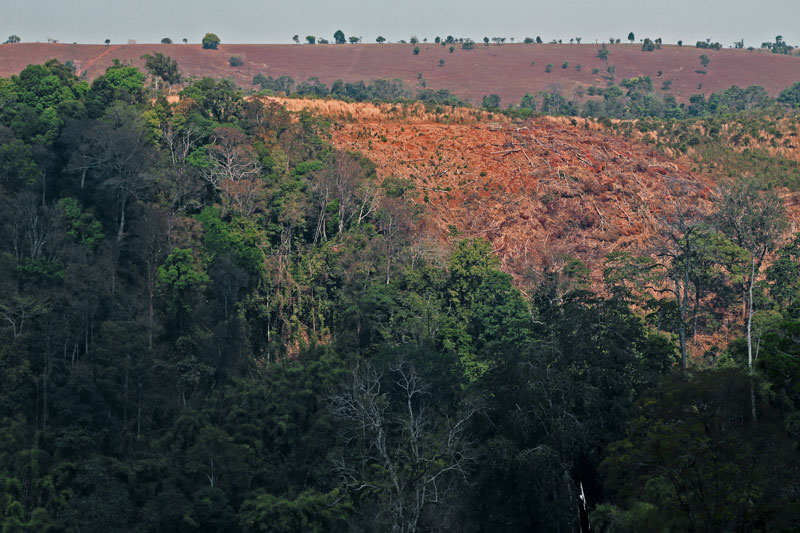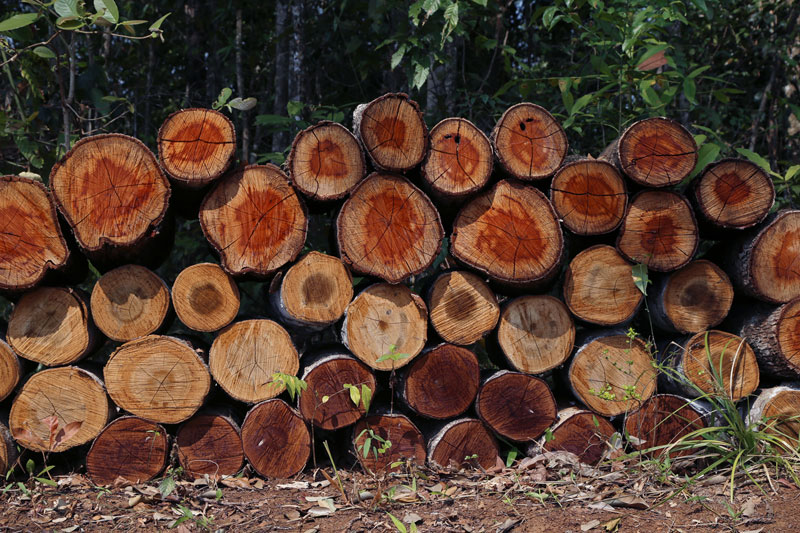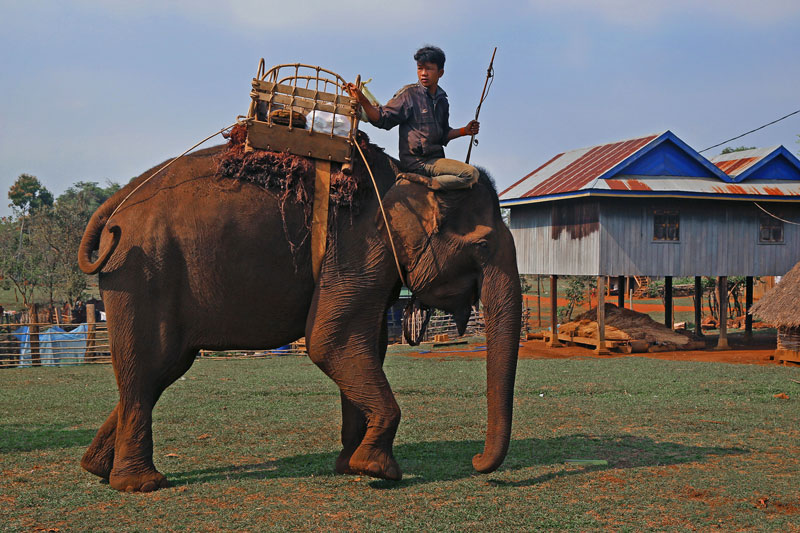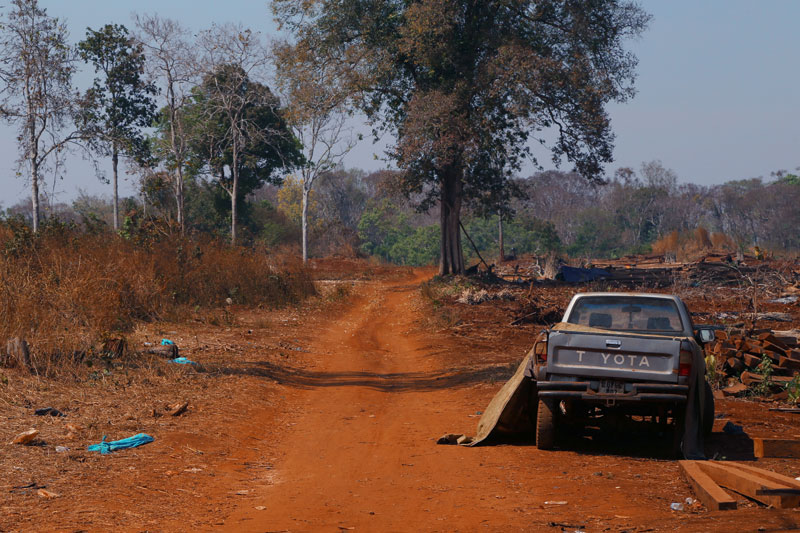Kam Put remembers when his village was surrounded by lush forest. “But now,” he said, “only 20 percent is left.”
Mr. Put, 31, is ethnic Lun, one of eight indigenous minority groups in Ratanakkiri province. A member of the Phnom Kuk commune council in Veun Sai district, he says the trees on his ancestral land have vanished in recent years.

“The deforestation started in 2000, and got worse in 2009 when the company showed up,” Mr. Put said, referring to a Vietnamese-owned rubber plantation that was granted a concession near his home.
More than 100 world leaders are currently in France for the 2015 U.N. Climate Change Conference in Paris—dubbed COP21—the latest diplomatic scramble to find global solutions to climate change.
In his address at the opening of the conference on Monday, King Norodom Sihamoni, who is leading the Cambodian delegation, called for urgent action.
“Climate change is the major challenge of our time, and its effects have been felt for a few years already,” the king said in his speech, delivered in French.
“The principal aspects of human development—such as agriculture, food security, access to water, health, migration, poverty—are under threat.”
Cambodia ranks among the countries most vulnerable to climate change, according to the U.N., due to its reliance on agriculture and raw resources, and lack of adaptive capacity.
The country is imperiled by fluctuations in weather patterns, severe droughts and flooding. The U.N. Development Program (UNDP) and the National Committee for Disaster Management found that 2,050 people died from natural disasters between 1996 and 2013.
Meanwhile, Cambodia has lost its status as a net carbon sink due to rapid deforestation, which disproportionately affects indigenous people like Mr. Put.

Cambodia’s ethnic minorities, concentrated in the northeastern highlands and in clusters across the country, are among the most threatened by climate disruption.
“Indigenous communities, in Cambodia and globally, are often particularly vulnerable to climate change, because their livelihoods, traditions and identities are so closely linked to and dependent on the use of natural resources,” said Maureen Harris, acting legal director for the Mekong region at EarthRights International.
Ethnic minorities in Cambodia are already disempowered by the rapid loss of their resources at the hands of plantations, hydropower projects, logging and mining, according to Ms. Harris.
“Climate change will increase these threats,” she said.
In the lead-up to COP21, the Asia Indigenous Peoples Pact released the “Asia Report on Indigenous Peoples and Climate Change,” based on input from organizations in 12 countries, including Cambodia.
While indigenous groups tend to “live simple and sustainable lifestyles, inflicting minimal damage to the environment and leaving negligible carbon footprints,” the report says, increasingly frequent natural disasters “have resulted in greater food insecurity, destruction of livelihoods, lands and resources”—in sum, “grave suffering for millions of indigenous peoples in Asia.”

The Cambodian government has exerted some effort to address climate change, launching a Climate Change Strategic Plan for 2014 to 2023. For COP21, the government shared its key strategies in its Intended Nationally Determined Contribution (INDC) document.
One priority is increasing forest cover, which the government has committed to bumping up to 60 percent of the country’s land area by 2030.
U.S. satellite data shows that deforestation in Cambodia is accelerating at a higher rate than in any other country. In 1990, the World Bank noted, forests blanketed 73 percent of the country’s land area. By 2010, that figure dropped to 57 percent.
According to Global Forest Watch, a program of the Washington-based World Resources Institute, the country lost 14,471 square km of forestland between 2001 and 2013. Rights group Licadho found that Cambodia lost about 1,560 square km last year alone.
The government aims to achieve its 60-percent target by classifying more forested land as protected, to avoid deforestation, and by better monitoring the lucrative timber trade.
But as a Cambodia Daily report uncovered in August, logging and economic land concessions granted to agro-industry firms encroach upon even the country’s supposedly protected areas. Almost a third of forest loss last year occurred inside protected areas, according to Licadho.
The government acknowledged in its INDC that Cambodia’s priority was still poverty reduction and economic growth.
“The pressure on resources and land is high,” it said.

And it’s not just the trees that are disappearing, Mr. Put said. Mining, logging and other commercial activities that are contributing to climate change are also erasing indigenous traditions.
“It really affects the community, especially their work on agriculture,” he said.
Mr. Put’s family, like members of other indigenous groups in the Cambodian highlands, once practiced swidden farming, in which farmers clear land, grow a diverse range of crops, harvest, then leave the soil to fallow while moving elsewhere to start the cycle again. The process allows the soil to rejuvenate naturally, without artificial fertilizers.
“We have stopped some traditional practices such as rotational farming after land was seized and cleared by the company,” Mr. Put said.
For many indigenous people—in the highlands, Koh Kong province’s Areng Valley, and elsewhere—clear-cutting also means the loss of sacred forests.
“The spirit forests are where their ancestors are. When that’s sold off, you lose your connection, your identity,” said Andre Papadimitrou, a volunteer adviser to the Highlanders Association, an NGO based in Ratanakkiri.
“That sense of community is slowly falling apart.”

While indigenous groups are among the most impacted by climate change, they are also in a poor position to adapt to that change, said Ms. Harris of EarthRights International.
“Despite Cambodia’s endorsement of the Declaration on the Rights of Indigenous Peoples [in 2007], indigenous communities affected by land concessions, hydropower dams and other large-scale projects have rarely been consulted, let alone afforded the right to free, prior and informed consent,” she said.
According to Cambodia’s 2001 Land Law, legally recognized indigenous communities have the right to apply for communal land titles.
“Everyone is on tracts of land that they consider ancestral land. Almost all of them don’t have a soft or hard title of their land,” Mr. Papadimitrou said of the minority groups in Ratanakkiri.
Many indigenous people are unaware of their rights, he added, or lack the resources to initiate the slow and complex process of acquiring titles. As of last year, only eight communal titles have been issued across the country, more than a decade after the Land Law took effect.

Losing land has stripped indigenous communities of their capacity to manage forests, water and other natural resources, further hindering their ability to adapt to future climate-related changes, Ms. Harris said.
Moreover, this resource scarcity is often accompanied by poverty: A 2013 World Bank report states that poverty rates among ethnic minority households was 6.5 percent higher than among Khmer households.
While many indigenous people are now working on rubber or cassava plantations on land that once belonged to their ancestors, their income is low and they have little in the way of savings or material wealth.
“They need to have assets…that they can utilize when someone is sick or there’s a drought,” Mr. Papadimitriou said, adding that without that financial security, ethnic minorities have little to fall back on in the event of natural disasters.
In Paris on Monday, King Sihamoni made a request of his fellow leaders.
“Representing a developing country, I deeply wish that the principle of equity will be at the heart of negotiations,” he said.
Indigenous communities hope for the same at home.



